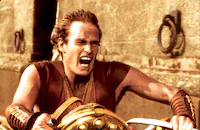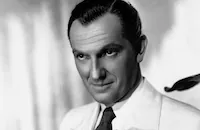The Greatest Story Ever Told

Brief Synopsis
Cast & Crew
George Stevens
Max Von Sydow
Dorothy Mcguire
Robert Loggia
Charlton Heston
Michael Anderson Jr.
Film Details
Technical Specs

Synopsis
The life of Jesus Christ is depicted; highlights include: His birth in Bethlehem, Herod's decree ordering the slaughter of all male children in Bethlehem; the flight of the Holy Family into Egypt, Jesus' baptism by John the Baptist, the selection of the Twelve Apostles, the execution of John the Baptist, the resurrection of Lazarus from the dead, the expulsion of the moneylenders from the temple in Jerusalem, the Last Supper and subsequent betrayal by Judas, the Crucifixion, and the Resurrection.

Director

George Stevens
Cast

Max Von Sydow

Dorothy Mcguire
Robert Loggia

Charlton Heston

Michael Anderson Jr.

Robert Blake
Burt Brinckerhoff
John Considine
Jamie Farr
David Hedison
Peter Mann

David Mccallum

Roddy Mcdowall
Gary Raymond
Tom Reese
David Sheiner
Ina Balin

Janet Margolin
Michael Tolan

Sidney Poitier
Joanna Dunham

Carroll Baker

Pat Boone

Van Heflin

Sal Mineo

Shelley Winters
Ed Wynn

John Wayne

Telly Savalas

Angela Lansbury
Johnny Seven

Paul Stewart

Harold J. Stone

Martin Landau

Nehemiah Persoff

Joseph Schildkraut

Victor Buono
Robert Busch
John Crawford

Russell Johnson

John Lupton

Abraham Sofaer
Chet Stratton
Ron Whelan

Jose Ferrer

Claude Rains

John Abbott
Rodolfo Acosta

Michael Ansara

Philip Coolidge
Dal Jenkins
Joseph Perry
Marian Seldes

Donald Pleasence

Richard Conte

Frank De Kova
Joseph Sirola
Cyril Delevanti
Mark Lenard

Frank Silvera
The Inbal Dance Theatre Of Israel
Crew
Tom Andre
Del Armstrong
Nathan R. Barragar
James Lee Barrett
Marjorie Best
Ridgeway Callow
William Creber
Ken Darby
Frank I. Davis
Richard Day
Carmen Dirigo
John Dutton
Eliot Elisofon
A. Arnold Gillespie
Sam Gordon
Ray Gosnell
Loyal Griggs
William Hale
David Hall
Robert R. Hoag
J. Mcmillan Johnson
Harold F. Kress
Lee Lukather
Fred Maclean
William C. Mellor
Franklin Milton
Ray Moyer
Argyle Nelson Jr.
Alfred Newman
Vittorio Nino Novarese
Frank O'neill
Norman Rockett
Carl Sandburg
Clarence Slifer
Eric Stacey
Lynn Stalmaster
William Steinkamp
George Stevens Jr.
George Stevens
George Stevens
Jack Tait
Richard Talmadge
Tony Van Renterghem
John Veitch
Antonio Vellani
Charles Wallace
Saul Wurtzel

Videos
Movie Clip




Trailer
Hosted Intro
Film Details
Technical Specs

Award Nominations
Best Art Direction
Best Cinematography
Best Costume Design
Best Score
Best Special Effects
Articles
The Greatest Story Ever Told
Shot on location in Utah and Arizona, locations that could effectively double as Palestine at the time of Christ, The Greatest Story Ever Told was a monumental shoot that matched its story's epic nature. Thousands of extras, countless crewmembers, and at least 25 high profile actors and actresses dotted the landscape behind the camera (Poet Carl Sandburg even gets listed in the credits as a Creative Consultant!). Director George Stevens' penchant for endless retakes did not help the often combative situations that arose during the production. In fact, the overtime pay for crewmembers was often larger than the regular salaries of many of the people involved. At one point, snow blanketed the landscape of what was supposed to be a desert, so an armada of snowplows had to be engaged, along with wheelbarrows, shovels, and butane flame-throwers to remove the snow. The production eventually headed back to Hollywood where a huge replica of Jerusalem was built, thus skyrocketing the budget even higher. With all the post-production editing, the film's final length clocked out at 260 minutes. It was then cut down for general release to a length of 225 minutes. Still, further cuts were made and there is reportedly a version in distribution that is only 127 minutes. Regardless of the length, audiences stayed away in droves, making The Greatest Story Ever Told the greatest financial flop ever made until the release of Heaven's Gate in 1980.
However, the Hollywood film community felt differently toward The Greatest Story Ever Told and nominated it for five Academy Awards including nominations for Best Cinematography, Best Score, Best Art Direction, Best Costume Design, and Best Visual Effects. Although the film scored zero statuettes at the April 18, 1966 ceremony, it went on to become a popular rental film at churches, schools, and film societies in the non-theatrical market. Of course, this was no consolation to United Artists who fully expected The Greatest Story Ever Told to sweep the Oscars but religious epics were passe by the mid-sixties and the studio should have sensed that.
Seen today, however, The Greatest Story Ever Told is a fascinating time capsule. Director George Stevens made it between his Oscar winning drama, The Diary of Anne Frank (1959) and The Only Game in Town (1970), two modestly budgeted films with small casts. There is also a certain perverse fascination in watching famous actors in cameo roles such as Telly Savalas as Pontius Pilate, Claude Rains as Herod, Dorothy McGuire as the Virgin Mary, Donald Pleasence as the Devil, and Shelley Winters yelling "I'm cursed" as the woman with no name. They even cast Pat Boone, Sal Mineo, and David McCallum (Ilya on TV's The Man From U.N.C.L.E. series) in hopes of attracting a younger audience. Luckily, the central role of Jesus is convincingly played by Max von Sydow, an internationally renown Swedish actor best known for his work in the films of Ingmar Bergman.
There is a great story behind The Greatest Story Ever Told that involves director George Stevens and superstar John Wayne in the role of a Roman centurion. His one line in the picture was: "Truly, this man was the Son of God." After a couple of attempts at the seemingly simple line, Stevens gently told him, "Duke, what we need in this line is something more. Look up at the man and give us some awe." Wayne nodded affirmatively, Stevens signaled the cameras to roll, and Wayne said, "Awww, truly this man was the Son of God." This anecdote probably never happened, but when John Wayne heard the story he even admitted to friends and associates that it made a great tale.
Producer: Frank I. Davis (executive), George Stevens Jr. (associate), George Stevens, Antonio Vellani (associate)
Director: George Stevens, David Lean (uncredited), Jean Negulesco (uncredited)
Screenplay: James Lee Barrett, Henry Denker (source writings), Fulton Oursler (book), George Stevens
Production Design: William J. Creber, Richard Day, David S. Hall, Fred M. MacLean, Ray Moyer, Norman Rockett
Cinematography: Loyal Griggs, William C. Mellor
Costume Design: Marjorie Best, Vittorio Nino Novarese
Film Editing: Harold F. Kress, Art J. Nelson, Frank O'Neil
Original Music: Hugo Friedhofer, Alfred Newman, Fred Steiner
Principal Cast: Max von Sydow (Jesus), Michael Anderson Jr. (James the Younger), Carroll Baker (Veronica), Ina Balin (Martha of Bethany), Pat Boone (Young Man at the Tomb), Victor Buono (Sorak), Richard Conte (Barabbas), Van Heflin (Bar Amand), Angela Lansbury (Claudia), Martin Landau (Caiaphas), Janet Margolin (Mary of Bethany), Roddy McDowall (Matthew), Sidney Poitier (Simon of Cyrene), Claude Rains (King Herod), John Wayne (The Centurion), Robert Blake (Simon the Zealot), Telly Savalas (Pontius Pilate), Donald Pleasence (The Dark Hermit), Charlton Heston (John the Baptist), Shelley Winters (Woman of No Name), Jose Ferrer (Herod Antipas), Robert Loggia (Joseph).
C-200m. Letterboxed.
by Scott McGee

The Greatest Story Ever Told
Quotes
Trivia
Cinematographer William C. Mellor suffered a heart attack, collapsed and died on the set.
Telly Savalas shaved his head bald for his role as Pontius Pilate. He kept his head shaved for the rest of his life.
During filming the first snowstorm to strike Arizona in decades buried the whole set. Several hundred cast and crew members, including director George Stevens, went out with snow shovels, wheelbarrows, bulldozers, and butane flame throwers to clear the snow from the set. Just as they were done, it snowed again, even harder than before -- forcing the production to close and move to Desilu Studios in Hollywood.
Joanna Dunham, who played Mary Magdalene, became pregnant during filming. The director worked around this by shooting her from the chest up as much as possible, making her later scenes markedly unlike the earlier ones.
Director George Stevens originally hired 550 Navajos from a local reservation to be Roman legionnaires, but they couldn't stay on the set for very long and eventually went back home to participate in a tribal election. Stevens replaced them with ROTC cadets.
'David Lean' directed some scenes for 'George Stevens' who was bogged down with the production. He was between Lawrence of Arabia (1962) and _Dr. Zhivago (1965)_ and was not credited
Notes
Location scenes filmed in Glen Canyon, Utah. Presented in Cinerama for roadshow engagements. For the final release version the roles of Shelley Winters and John Wayne, among others, were reduced or eliminated.

Miscellaneous Notes
Released in United States Winter February 15, 1965
Released in United States on Video March 6, 2001
Released in United States April 1981
aspect ratio 2.75:1
Released in United States Winter February 15, 1965
Released in United States on Video March 6, 2001
Released in United States April 1981 (Shown at FILMEX: Los Angeles International Film Exposition (Easter Special) April 2-23, 1981.)
Voted One of the Year's Ten Best Films by the 1965 National Board of Review.
















